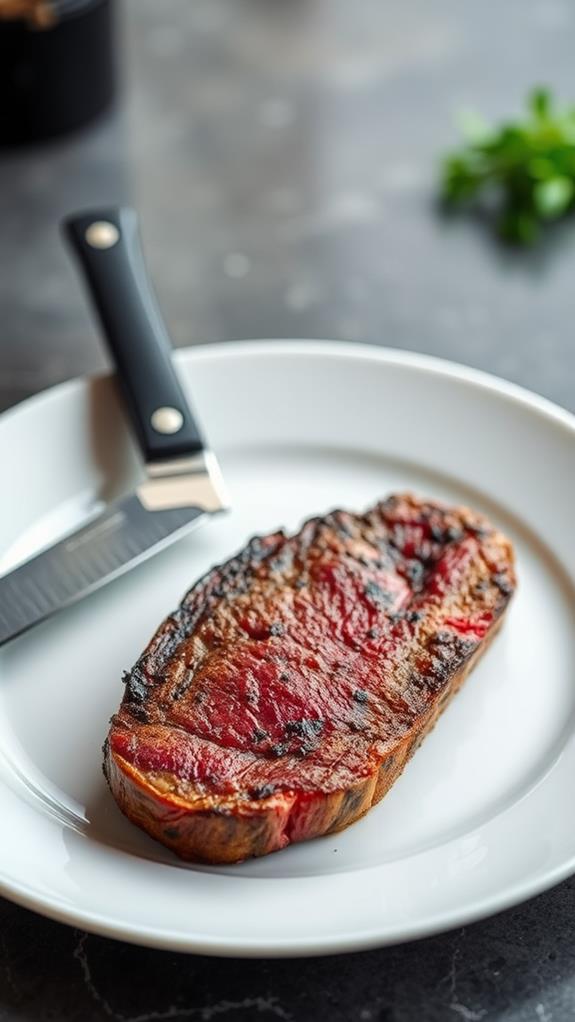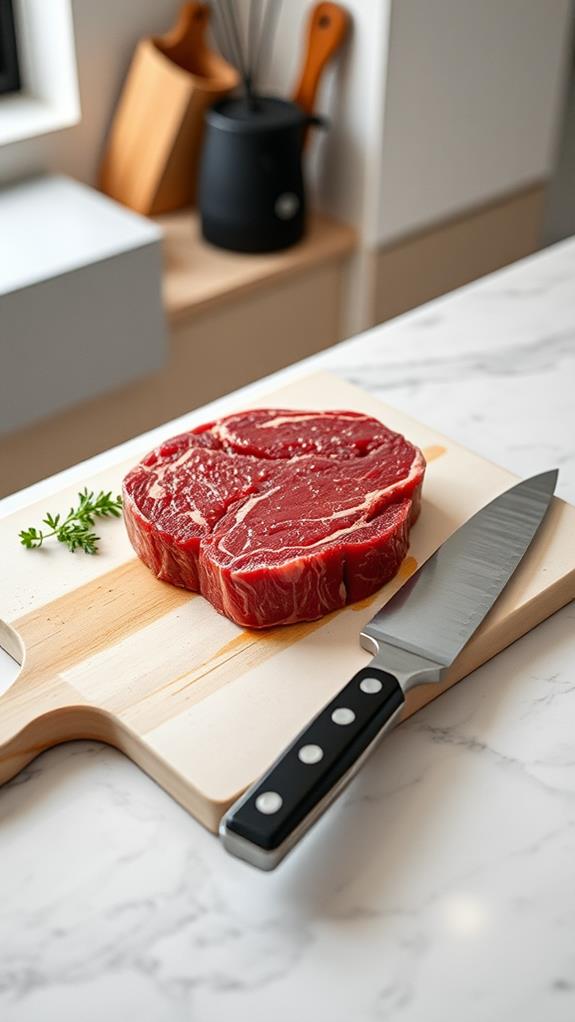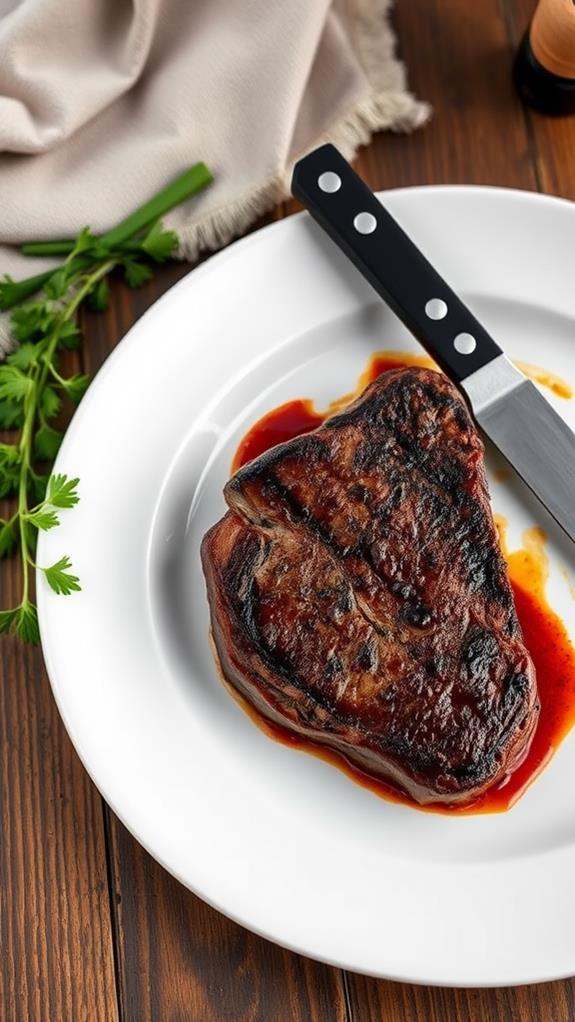Is It Safe to Eat Blue Rare Steak
Eating blue rare steak isn't entirely safe, as it carries potential health risks. The minimal cooking process can leave harmful bacteria on the surface, potentially causing foodborne illnesses. While proper handling and sourcing can reduce these risks, it's not a foolproof method. Vulnerable populations, such as pregnant women, young children, and those with compromised immune systems, should avoid blue rare steak altogether. Food safety experts remain divided on the issue, with some arguing it's safe when prepared correctly, while others maintain it's never worth the risk. To ponder various factors and expert opinions, you'll need to evaluate the situation.
This post may contain affiliate links. If you make a purchase through these links, I may earn a commission at no additional cost to you. Additionally, portions of this post may be generated using artificial intelligence (AI) technology. While we strive for accuracy, please be aware that AI-generated content may not always be perfect and should be fact-checked when necessary.
The Spatula Scoops
- Blue rare steak carries potential health risks due to harmful bacteria and parasites that can survive on undercooked meat.
- Proper handling, sourcing, and cooking techniques can reduce but not eliminate the risks associated with blue rare steak.
- Vulnerable populations, including pregnant women, children, elderly, and immunocompromised individuals, should avoid consuming blue rare steak.
- Expert opinions are divided on the safety of blue rare steak, with some arguing it's safe when prepared correctly.
- Alternative cooking methods, like sous-vide, may offer safer options for those who prefer minimally cooked steak.
Understanding Blue Rare Steak

Blue rare steak, also known as "blue," refers to the absolute minimum level of cooking for a steak. When you order a blue rare steak, you're asking for a piece of meat that's been seared on the outside for just a few seconds on each side. The interior remains fundamentally raw, with a cool, red center. This cooking method results in a steak that's barely warm throughout, with a temperature typically between 115°F and 120°F. For ideal results, it's important to use a pre-seasoned cast iron skillet that retains heat effectively, ensuring even cooking and a perfect sear on the steak's exterior.
The term "blue" originates from the blueish or purple hue the meat takes on when it's first cut. This color quickly changes to red as the meat is exposed to oxygen. To achieve a blue rare steak, chefs usually use high heat to quickly sear the exterior, creating a thin crust while leaving the inside untouched. This method preserves the steak's natural flavors and tenderness, which some steak enthusiasts prefer.
It's important to note that blue rare steak isn't suitable for all cuts of beef. Prime cuts like filet mignon or ribeye are best for this preparation, as they're typically more tender and less prone to foodborne illnesses.
Potential Health Risks
Consuming blue rare steak carries several health risks that you should consider. The main concern is the potential presence of harmful bacteria like E. coli, Salmonella, and Listeria. These pathogens can survive on the surface of the meat when it's not thoroughly cooked. While searing the outside of the steak can kill some bacteria, it doesn't guarantee complete elimination. Similar to wild rabbit consumption, proper handling and cooking techniques are indispensable to safeguard your health. It merits noting that cooking meat to an internal temperature of at least 165°F (74°C) is recommended to eliminate harmful pathogens.
Another risk is parasitic infections, such as toxoplasmosis or tapeworms. These parasites can be present in raw or undercooked beef and may cause serious health issues if ingested. People with compromised immune systems, pregnant women, young children, and the elderly are particularly vulnerable to these risks.
You should also be aware of the potential for cross-contamination. When preparing blue rare steak, bacteria from the raw meat can spread to other surfaces and foods, increasing the risk of foodborne illness. To mitigate these risks, it is indispensable to use proper food handling techniques, including sanitizing utensils and surfaces that come into contact with raw meat. If you choose to consume blue rare steak, ensure you're sourcing high-quality meat from reputable suppliers and understand the potential health implications.
Proper Handling and Sourcing

To minimize the risks associated with blue rare steak, proper handling and sourcing are essential. You'll want to start by purchasing your meat from a reputable butcher or grocery store. Look for high-quality, fresh cuts of beef that have been properly refrigerated. When you're ready to prepare the steak, guarantee your hands, utensils, and work surfaces are clean to prevent cross-contamination. While steak doesn't require the same internal temperature as chicken, it's still important to follow safe food handling practices to avoid foodborne illnesses.
It's pivotal to store your steak at the correct temperature. Keep it refrigerated at 40°F (4°C) or below until you're ready to cook. When it's time to prepare the steak, use separate cutting boards and utensils for raw meat to avoid spreading bacteria. Cook the exterior of the steak quickly at high heat to kill surface bacteria while leaving the interior rare.
Expert Opinions
Consensus among food safety experts on blue rare steak remains divided. You'll find that some professionals argue it's safe when proper handling and sourcing procedures are followed, while others maintain that it's never worth the risk. Those in favor often point to the low occurrence of foodborne illness from properly prepared blue rare steak, citing that surface bacteria are killed during searing.
On the other hand, skeptics emphasize the potential dangers of consuming undercooked meat, especially for vulnerable populations like pregnant women, children, and the elderly. They argue that internal temperatures below 145°F (63°C) don't guarantee the elimination of harmful pathogens.
When researching expert opinions, you'll encounter terms like "time-temperature combination" and "pathogen reduction." These refer to the relationship between cooking duration and temperature needed to kill bacteria. Some experts propose alternative methods, such as sous-vide cooking, which can achieve pathogen reduction at lower temperatures over extended periods.
Ultimately, you'll need to weigh the risks and benefits based on the available information. If you choose to eat blue rare steak, verify you're sourcing from reputable suppliers and following strict food safety protocols.
Making an Informed Decision

Armed with expert opinions and safety considerations, you're now better equipped to make an informed decision about eating blue rare steak. Consider your personal health status and risk tolerance when deciding. If you have a compromised immune system, are pregnant, or have certain medical conditions, it's best to avoid blue rare steak altogether.
For healthy adults, the risk is lower but still present. Weigh the potential benefits of taste and texture against the possibility of foodborne illness. If you choose to eat blue rare steak, verify you're getting it from a reputable source that follows strict food safety protocols. Ask about their meat handling practices and cooking methods.
Frequently Asked Questions
Can Pregnant Women Safely Eat Blue Rare Steak?
As a pregnant woman, you shouldn't eat blue rare steak. The low cooking temperature doesn't kill potentially harmful bacteria like E. coli or Listeria. These pathogens can cause serious complications for you and your baby. It's best to cook your steak to at least medium-well (160°F internal temperature) to guarantee it's safe. While you might miss the juicy texture of rare steak, it's imperative to prioritize your health and your baby's well-being during pregnancy.
How Does Blue Rare Steak Compare to Other Cooking Methods Nutritionally?
You'll find that blue rare steak retains more nutrients compared to well-done cuts. It's higher in vitamin B12, zinc, and iron, as these can be lost during longer cooking times. However, the protein content remains relatively constant across cooking methods. While blue rare offers nutritional benefits, it is crucial to recognize that it also carries a higher risk of foodborne illness. Always consider food safety when choosing your preferred steak doneness.
Are There Any Religious or Cultural Restrictions on Eating Blue Rare Steak?
You'll find that religious and cultural restrictions on eating blue rare steak vary. Some religions, like Judaism and Islam, prohibit consuming blood, which is more present in rare meats. Certain cultures, particularly in Western countries, may embrace rare steak consumption, while others prefer well-done meat. Health concerns in some regions might discourage eating undercooked meats. It is crucial to respect individual beliefs and cultural norms when considering blue rare steak consumption, as preferences and restrictions can differ remarkably among communities.
Can Blue Rare Steak Be Reheated Safely for Later Consumption?
You shouldn't reheat blue rare steak for later consumption. The brief cooking process leaves the meat's interior largely uncooked, potentially allowing bacteria to multiply during storage. Reheating may not effectively kill these bacteria, increasing your risk of foodborne illness. If you have leftovers, it's safer to fully cook the steak before storing and reheating. For best safety and quality, it's recommended to consume blue rare steak immediately after preparation and avoid saving it for later.
Does the Type of Cattle Breed Affect the Safety of Blue Rare Steak?
Believe it or not, the cattle breed doesn't materially affect blue rare steak safety. You're dealing more with preparation and handling. The key factors are the steak's quality, freshness, and how it's stored and cooked. Whether it's Angus, Hereford, or Wagyu, proper food safety practices are vital. You'll want to guarantee the meat's from a reputable source, stored at the right temperature, and prepared with clean utensils. Remember, the surface bacteria are what you're mainly concerned about with blue rare steak.
Conclusion
As you weigh the decision to indulge in blue rare steak, picture a sizzling, deep red center barely kissed by heat. While it's a delicacy for some, it's not without risks. You'll need to reflect on the potential health hazards, safeguard proper handling and sourcing, and heed expert advice. Ultimately, it's your choice to make. If you do opt for blue rare, be sure to select high-quality meat from reputable sources and follow strict food safety guidelines to minimize risks.





